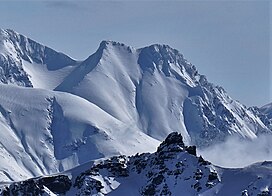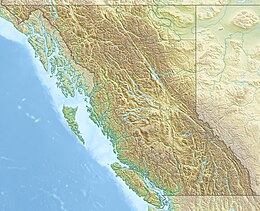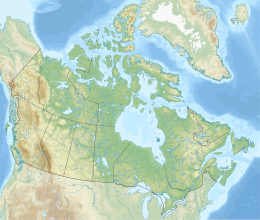Diavolo Peak is a 2,569-metre (8,428-foot) mountain located in British Columbia, Canada.
| Diavolo Peak | |
|---|---|
 West aspect of Diavolo/Angelo | |
| Highest point | |
| Elevation | 2,569 m (8,428 ft)[1][2] |
| Prominence | 83 m (272 ft)[1] |
| Parent peak | Overlord Mountain (2,625 m)[1] |
| Isolation | 0.669 km (0.416 mi)[1] |
| Listing | Mountains of British Columbia |
| Coordinates | 50°0′20″N 122°48′57″W / 50.00556°N 122.81583°W[3] |
| Naming | |
| Etymology | diavolo (devil) |
| Geography | |
| Country | Canada |
| Province | British Columbia |
| District | New Westminster Land District |
| Protected area | Garibaldi Provincial Park |
| Parent range | Fitzsimmons Range Garibaldi Ranges Coast Mountains |
| Topo map | NTS 92J2 Whistler[3] |
| Climbing | |
| First ascent | 1923 by Neal Carter |
Description
editDiavolo Peak is the fifth-highest peak of the Fitzsimmons Range which is a subrange of the Garibaldi Ranges.[1] It is situated 16 km (10 mi) southeast of Whistler in Garibaldi Provincial Park, and the nearest higher peak is Mount Benvolio, 669 metres (2,195 ft) to the north-northeast.[1] The Diavolo Glacier rests on the east aspect of the peak. Precipitation runoff from the peak and meltwater from the glacier drains into tributaries of the Cheakamus River. Topographic relief is significant as the summit rises 1,500 metres (4,921 ft) above the river in two kilometres (1.24 mile).
History
editThe first ascent of the mountain was made on September 18, 1923, by Neal M. Carter and Charles T. Townsend.[4]
Diavolo is an Italian word, meaning "devil", and the peak was so-named by Carter and Townsend because of a steep, rotten arête and black-colored rock. They named its subsidiary peak "Angelo" because it looked easy to climb and angelic by comparison.[4] Angelo is an Italian word, meaning "angel".
The mountain's toponym was officially adopted on September 2, 1930, by the Geographical Names Board of Canada.[3]
Climate
editBased on the Köppen climate classification, Diavolo Peak is located in the marine west coast climate zone of western North America.[5] Most weather fronts originate in the Pacific Ocean, and travel east toward the Coast Mountains where they are forced upward by the range (Orographic lift), causing them to drop their moisture in the form of rain or snowfall. As a result, the Coast Mountains experience high precipitation, especially during the winter months in the form of snowfall. Temperatures can drop below −20 °C with wind chill factors below −30 °C. The months July through September offer the most favorable weather for climbing Diavolo Peak.
Angelo Peak
editAngelo Peak is a subsidiary peak 185 meters south of Diavolo Peak. At 2,561-meters-elevation, it is the sixth-highest peak of the Fitzsimmons Range, but it has only 23 metres of prominence.[6] Angelo was first climbed by a British Columbia Mountaineering Club party on August 15, 1924.[7] The mountain's toponym was officially adopted on September 2, 1930, by the Geographical Names Board of Canada.[7]
See also
editReferences
edit- ^ a b c d e f "Diavolo Peak, Peakvisor.com". Retrieved 2023-05-11.
- ^ "Diavolo Peak, British Columbia". Peakbagger.com. Retrieved 2023-05-11.
- ^ a b c "Diavolo Peak". Geographical Names Data Base. Natural Resources Canada. Retrieved 2023-05-11.
- ^ a b "Diavolo Peak". BC Geographical Names. Retrieved 2023-05-11.
- ^ Peel, M. C.; Finlayson, B. L.; McMahon, T. A. (2007). "Updated world map of the Köppen−Geiger climate classification". Hydrol. Earth Syst. Sci. 11. ISSN 1027-5606.
- ^ "Angelo Peak, Peakvisor.com". Retrieved 2023-05-11.
- ^ a b "Angelo Peak". BC Geographical Names. Retrieved 2023-05-11.
External links
edit- Weather: Diavolo Peak

